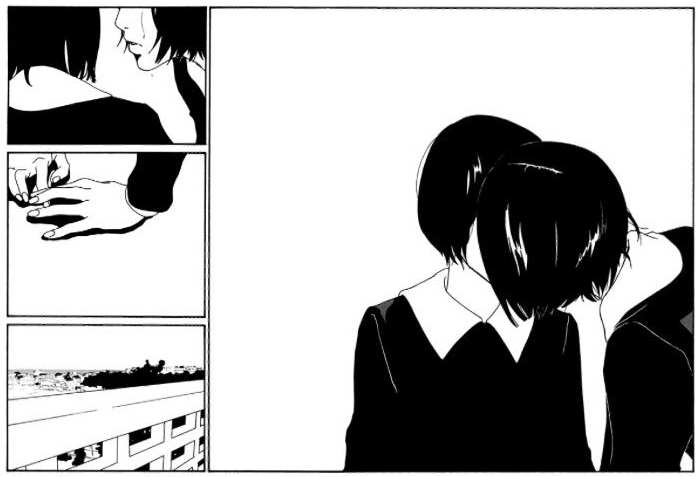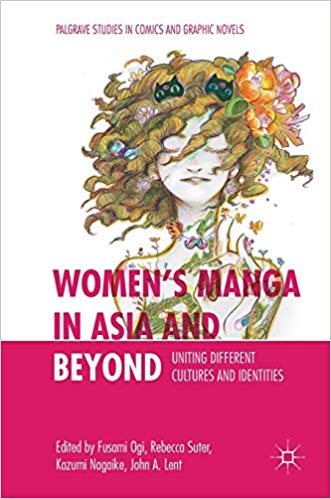Books: Women’s Manga etc…
June 25, 2019 · 1 comment
By Jonathan Clements.
 Women’s Manga in Asia and Beyond: Uniting Different Cultures and Identities seems at first glance like a grab-bag of buzzwords assembled to attract the attention of search engines rather than humans. The introduction by Fusami Ogi gives up on defining what manga actually means, and her colleague Kazumi Nagaike announces that “…the term ‘women’ in the title of this book… does not refer to biological women but includes other non-masculine subjects.” So by the time it begins in earnest, its notional title has already shifted to something more like Comics (and cultural products and activities) for, or by, or about Non-Masculine Subjects (some related to Japan, some not), All Over the Place. Its publication comes after an upwelling of books on similar themes, including contributions from some of the same authors (such as the same publisher’s recent Shojo Across Media), which leaves the impression, perhaps coincidentally and unfairly, that it is a compendium of all the left-overs from the last decade of conferencing.
Women’s Manga in Asia and Beyond: Uniting Different Cultures and Identities seems at first glance like a grab-bag of buzzwords assembled to attract the attention of search engines rather than humans. The introduction by Fusami Ogi gives up on defining what manga actually means, and her colleague Kazumi Nagaike announces that “…the term ‘women’ in the title of this book… does not refer to biological women but includes other non-masculine subjects.” So by the time it begins in earnest, its notional title has already shifted to something more like Comics (and cultural products and activities) for, or by, or about Non-Masculine Subjects (some related to Japan, some not), All Over the Place. Its publication comes after an upwelling of books on similar themes, including contributions from some of the same authors (such as the same publisher’s recent Shojo Across Media), which leaves the impression, perhaps coincidentally and unfairly, that it is a compendium of all the left-overs from the last decade of conferencing.
 Despite boasting four editors (surnames notably on the cover in Japanese a-ka-sa-ta order, not per the Roman alphabet), there is no unifying editorial policy, because “we wish to respect each author’s preference in dealing with different cultures and identities.” But if there’s no curatorial stance, editorial cohesion or even clear subject, then this just turns into a random collection of essays, less of a book and more like a one-issue journal with a vague pop-culture focus and no style-guide.
Despite boasting four editors (surnames notably on the cover in Japanese a-ka-sa-ta order, not per the Roman alphabet), there is no unifying editorial policy, because “we wish to respect each author’s preference in dealing with different cultures and identities.” But if there’s no curatorial stance, editorial cohesion or even clear subject, then this just turns into a random collection of essays, less of a book and more like a one-issue journal with a vague pop-culture focus and no style-guide.
With such a confused set of hand-waving non-guidelines, my hopes were not high for the articles in the book itself – a disservice to the contributors, since many of them have interesting things to say. Monica Chiu, for example, has a closely-argued reading of Kiriko Nananan’s Blue (pictured above) a “manga bound by and to heterosexual ideology.” Rebecca Suter has a fun appraisal of the uses and abuses of Australia as a location in manga, drawing on Australia’s liminal position at the edge of Asia as “both Self and Other.” Ryan Holmberg presents an informative and original account of Katsuji Matsumoto, a largely forgotten innovator in the world of girls’ manga. Akiko Sugawa-Shimada holds forth on the motivations behind cosplay in Singapore and the Philippines, Jessica Bauwens writes something about a Belgian comic about a Japanese girl, and Kazumi Nagaike investigates the subset of a subset of a subset: boys who like BL manga.
Fusami Ogi writes about the history and features of shojo manga, presenting some great examples for discussion and then observing the take-up of “manga” by artists outside Japan. Except since we are reading a book which begins with Ogi refusing to rule on what manga is, this is now just an article about comics. Similarly, Yukari Yoshihara writes an informative article about manga and Shakespeare, albeit one briefly compromised by beginning with the self-styled “Manga Shakespeare” series, the manga-ness of which was occasionally reasonably asserted, and occasionally just marketing guff (don’t take my word for it: see the comments here from some of its creators).
The elision of the words manga and comics is commonplace in Japan, where the language doesn’t really distinguish between them, but definition is vital in English if Anglophone research is going to have any value. As noted by Casey Brienza in Manga in America, there are all sorts of devious applications and contractual loopholes available to someone prepared to agree that “manga can come from anywhere,” but I expect a good deal more rigour in the wording employed by academia. Otherwise, what is it for?
Ace Vitancol and Scott WuMing both offer brief comments about their lives as comics artists in the Philippines, and Foo Swee Chin contributes something similar about the artist’s life in Singapore. I wish there were a whole book of such vignettes – it would be a wonderful source of inspiration along the lines of Mark Salisbury’s Writers on Comics Scriptwriting or the artist interviews in Masami Toku’s International Perspectives on Shojo and Shojo Manga, but I have no idea what they are doing in this collection. There should be more of them, or none at all. In the same vein, Madeleine Rosca turns up to say that “manga are comics drawn in a Japanese style”, but then offers a limited set of rules for what a “Japanese style” apparently is, that will be news to a whole bunch of people in Japan who draw for a living.
In other words, I see in this multi-headed editorial hydra a case of too many cooks ignoring the broth while it boils over – it is impossible to tell how much of a contribution the editors have already made to the integrity of the articles as published, but I am left wishing that some of the authors had been pushed a little harder to ground their comments in firmer citations, or challenged on solecisms that could have been fixed for more enduring scholarship.
Fran Martin, for example, claims that “tens of thousands of girls and women” are involved in boys-love homoerotic narratives, but offers no statistical source, either in Japan, or her Taiwan research area. She claims that online distribution in modern times makes it difficult to say for sure how big the market is, but she doesn’t provide any figures for the bad-old days of print, either. Martin corrals a lot of interesting-sounding sources, but derives her own conclusions from a set of interviews with just 30 people. Academically, there is nothing wrong with investigating a small population, and her findings are deeply interesting, but I would have preferred to see a fuller indication of how “popular” this popular culture really is.
 Katrien Jacobs, on the other hand, is prepared to delineate her study of a similar group in Hong Kong at an impressive 30,000 members, thanks to the public stats for one of its Facebook groups. Her interview population is similarly small,but by going both macro and micro, she is able to present an intriguing snapshot of political activism LGBT manga fandom, and (no, really) subversive Umbrella Revolution slash fiction in Hong Kong, and the struggles it experience within online filters.
Katrien Jacobs, on the other hand, is prepared to delineate her study of a similar group in Hong Kong at an impressive 30,000 members, thanks to the public stats for one of its Facebook groups. Her interview population is similarly small,but by going both macro and micro, she is able to present an intriguing snapshot of political activism LGBT manga fandom, and (no, really) subversive Umbrella Revolution slash fiction in Hong Kong, and the struggles it experience within online filters.
The last seven of the twenty chapters form a little mini-book all on their own: a powerful collection of essays on “Asian Women Comics Artists and Their Careers”, edited by John A. Lent and featuring heavy-hitters like Wendy Siuyi Wong and Queenie Chan, artist interviews and a disappointing offering from Stella So that promises “Manga in Hong Kong”, but turns out to be a picture-book resumé better filed with Vitancol and WuMing’s confessionals. “I am Stella So. I have been enjoying drawing since I was three. I have four uncles who lived with me when I was little,” she begins, in a book that retails in hardback at £89.99.
In case it’s not immediately obvious, the fragmented nature of this publication, particularly its division into sections with different curators, makes it come across like several different books trying to fight their way out from some arbitrarily applied covers. Although I am sure this will cause intersectionalists and inclusionists to clutch their pearls in horror, I wish that all concerned had published them separately, within more traditional enclosures: a book on creators, for example, which would have been exciting, and a book on fan activities that I could choose never to open.
But as noted above, none of this really seems to matter. The recurring failure of manga studies to define what manga is doesn’t seem to bother anyone, nor is anyone fretting about the lack of consistency in a book that is seemingly intended merely as a set of virtual shelves where future researchers can blunder into isolated chapters on online searches. That’s all very well, but why publish it as a book at all? If Palgrave wants to release an Asian pop-culture journal, maybe it should just get on with it instead of smuggling it out under hard covers.
Jonathan Clements is the author of A Brief History of China. Women’s Manga in Asia and Beyond: Uniting Different Cultures and Identities is published by Palgrave Macmillan.
JD
July 10, 2019 1:39 pm
Maybe the reason Palgrave Macmillan (an educational/academic publisher) is publishing this "under hard cover" is to test the waters? Or maybe they're publishing it, purely because it's an area of academia that is worth exploring? Heck, it may even simply be that there was no other reasonably intelligent or feasible manner in which to publish this set of articles, interviews and other assorted bits of work, other than the manner in which they have done? All of these are possibilities, but did you even bother contacting Palgrave to ask them? I don't think you did. You just assumed some facts, and then made a judgement based on that. Come on, Jonathan! You're better than that! Just because this book isn't being published in the way you would want it to be, or the way you would have done so, doesn't mean it's the wrong way. These books are meant for academics, not the lay public! Academic books aren't cheap, because they're aimed at academic libraries, academic institutions, and very specialised places that deal with the subject at hand. Sales will be in the low thousands, at best. You're reviewing academic tomes, on a blog for anime aimed at the lay public. You're basically reviewing something, condemning it, and then posting that review to a completely different audience. It'd be like me reviewng a book on Japan, complaining it wasn't what I was expecting, and then posting my review on a Singaporean Tourism blog. Wrong review, wrong locale, wrong time, wrong place!